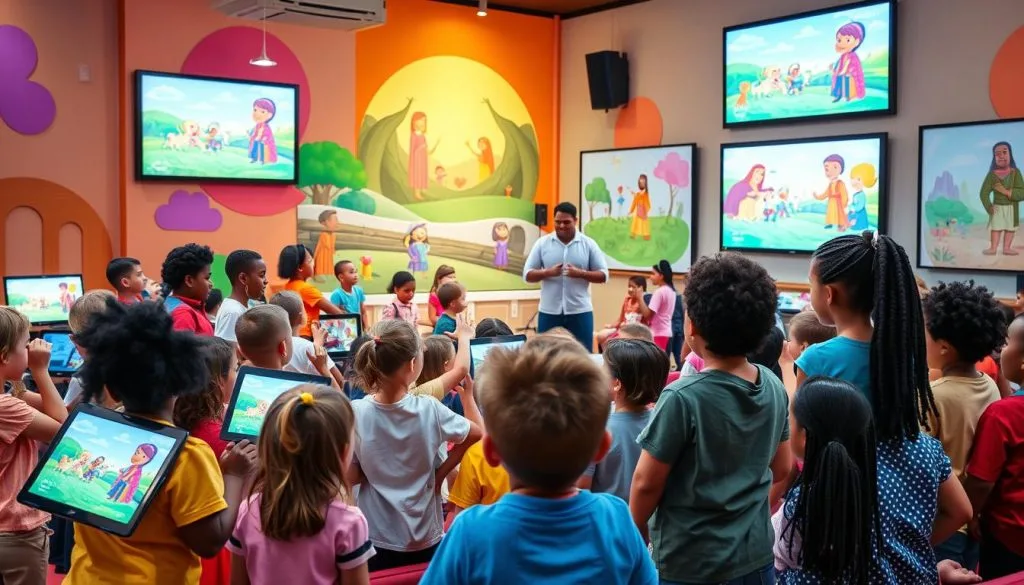In a bustling city, a welcoming church opens its doors to families. They come together in unity and faith. The children’s church program is where unity starts, nurturing young spirits.
Sarah, a devoted mother, remembers her son Ethan’s first time at children’s church. “I was nervous,” she says. “But from the start, we felt welcome. The teachers made Ethan feel included, and he made friends who loved learning about God.”
Stories like Sarah and Ethan’s are common in children’s church. These programs aim to promote unity by fostering inclusivity and nurturing spiritual growth. They create a safe space for kids to explore faith, make friends, and feel part of a community.
Key Takeaways
- Children’s church programs play a vital role in promoting unity within the congregation
- Fostering inclusivity and creating a welcoming environment are key to engaging young congregants
- Nurturing spiritual growth through engaging activities and curriculum is essential for strengthening the church community
- Effective children’s church programs can help bridge the gap between families and the church
- Leveraging technology and embracing diversity can enhance the reach and impact of these programs
Understanding the Importance of Unity in Children’s Church
Unity is key to a strong children’s church community. When kids work together, it helps their spiritual growth. It also makes a community that values diversity and builds strong bonds.
The Role of Unity in Spiritual Growth
Unity in children’s church programs deeply affects their spiritual growth. It teaches kids to respect and find common faith. This helps them understand spirituality better and connect with the divine.
Benefits of a Unified Church Community
A unified church community brings many benefits. Kids learn the importance of teamwork and diversity. This growth not only helps them but also makes the church welcoming to new families.
| Benefits of a Unified Church Community | Impact on Children |
|---|---|
| Stronger Sense of Belonging | Children feel valued and connected to the larger church family. |
| Increased Participation and Engagement | Children are more motivated to actively contribute to church activities and programs. |
| Enhanced Interfaith Understanding | Children develop a deeper appreciation for diverse religious and cultural backgrounds. |
| Improved Conflict Resolution Skills | Children learn to navigate differences and work through challenges collaboratively. |
By focusing on unity, leaders can build a vibrant community. This community supports spiritual growth, strengthens bonds, and celebrates diversity.
Elements of Effective Children’s Church Programs
Creating great children’s church programs needs careful thought. They must meet both spiritual and social needs of kids. At the core are engaging activities and curriculum, and fostering inclusive environments.
Engaging Activities and Curriculum
Good programs focus on engaging youth activities. These activities should be fun, interactive, and match kids’ interests and ages. The curriculum should instill moral values and help kids grow spiritually.
For example, games, arts, and role-playing can make learning fun. They help kids understand and apply biblical teachings. Interactive worship experiences let kids join in, explore faith, and connect with the church.
Fostering Inclusive Environments
It’s vital to make spaces welcoming and inclusive for all. Inclusive environments make sure every child feels valued and respected. This is done by celebrating diversity, understanding, and belonging.
- Offer multi-cultural activities to celebrate the church’s diversity.
- Have group discussions on acceptance, empathy, and shared values.
- Provide specialized support for kids with unique needs or disabilities.
By focusing on these elements, children’s church programs can be dynamic and inclusive. They inspire spiritual growth, strengthen community, and empower the next generation.
Strategies for Promoting Unity Among Children
Building community bonds, fostering inclusivity, and nurturing spiritual growth are key in children’s church programs. Using team-building exercises and group discussions is very effective.
Team-Building Exercises and Games
Children can feel united through games and activities. Teamwork-focused exercises help them solve problems, communicate, and understand each other. This builds strong bonds in the church community.
- Cooperative puzzles or scavenger hunts that require children to work together
- Interactive games that promote trust, such as “Trust Fall” or “Human Knot”
- Arts and crafts projects that involve group creativity and planning
Group Discussions on Shared Values
Group discussions about shared values and beliefs are powerful. They help foster inclusivity and nurture spiritual growth. Children can share their thoughts, listen, and find common ground.
- Discussions on topics like kindness, respect, and service to others
- Sharing personal experiences and how they relate to the church’s spiritual teachings
- Brainstorming ways to apply their shared values in their daily lives
By using these strategies, leaders can create a united and vibrant church community. Building community bonds, fostering inclusivity, and nurturing spiritual growth become part of everyday life.

Involving Parents and Guardians in Church Programs
Getting parents and guardians involved in children’s church programs is key. It helps build a strong community and creates meaningful connections. Churches can make a welcoming space for building community bonds, engaging youth activities, and multicultural celebrations.
Encouraging Parental Participation
Getting parents involved is crucial for a strong bond between children, families, and the church. Churches can do this by:
- Hosting regular parent-teacher meetings to discuss children’s progress and address any concerns.
- Inviting parents to volunteer in various capacities, such as leading small group discussions or assisting with classroom activities.
- Providing opportunities for parents to share their expertise, cultural traditions, or hobbies with the children.
Hosting Family-Focused Events
Organizing events for families is a great way to unite the church community. These events can include:
- Multicultural potluck dinners where families can share traditional dishes and learn about each other’s cultural heritage.
- Family game nights or movie screenings that encourage intergenerational bonding and fun.
- Service projects that allow families to work together to make a positive impact on the community.
By involving parents and guardians in children’s church programs, churches can foster a sense of belonging. This strengthens the bonds within the community. It benefits the children and makes the church a more inclusive and vibrant place for everyone.
Utilizing Technology to Enhance Children’s Church Programs
In today’s world, using technology can really help kids’ church programs. Churches can use online tools and virtual meetings to make worship more fun and inclusive. This way, kids can feel connected and united, even when they’re apart.
Online Resources and Platforms
Churches have many online tools to make kids’ programs better. They can find interactive Bible studies, fun multimedia, and lesson plans online. These tools help make worship exciting for today’s kids.
Virtual Gatherings for Broader Inclusion
Since the COVID-19 pandemic, online meetings are key for church programs. This includes kids’ church too. Online, churches can hold engaging youth activities that welcome kids from all over. Kids can join in, learn, and grow in faith, even if they can’t meet in person.
| Online Resources | Virtual Gatherings |
|---|---|
|
|

“Technology has the power to transform children’s church programs, making them more engaging, inclusive, and impactful than ever before. By embracing the digital landscape, churches can create meaningful connections and inspire young minds to grow in their faith.”
Celebrating Diversity Within Church Programs
At the heart of a thriving children’s church is embracing diversity. Celebrating the rich cultural tapestry in our congregations fosters unity and belonging. This section looks at the power of multicultural activities and lessons on acceptance and understanding.
It invites children to explore the beauty of interfaith collaboration and the joy of embracing diversity.
Multi-Cultural Activities for Children
Engaging children in multicultural celebrations sparks their curiosity and appreciation for diversity. From festivals with traditional dances and costumes to art workshops inspired by cultures, the options are vast. These experiences broaden their horizons and teach them to respect diverse backgrounds in our church community.
Lessons on Acceptance and Understanding
It’s also key to create an environment of acceptance and understanding. Through thoughtful lessons and discussions, children learn to respect differences and celebrate unique identities. By teaching empathy and open-mindedness, we help our young congregants become champions of inclusivity.
They learn to see diversity as a source of strength and unity.
| Multicultural Celebrations | Lessons on Acceptance |
|---|---|
|
|
By embracing diversity and fostering multicultural celebrations and lessons, children’s church programs create a vibrant, inclusive community. This approach strengthens the spiritual growth of our young congregants. It also lays the foundation for a more united and compassionate future.
https://www.youtube.com/watch?v=tETTSgS4ZpE&pp=ygUJI2RpdmVyc2V2
“Diversity is not about how we differ. Diversity is about embracing one another’s uniqueness.” – Ola Joseph
Training Leaders to Foster Unity
Effective children’s church programs need dedicated leaders. These leaders help grow spirituality, promote inclusivity, and teach moral values. They are key to creating a unified community that supports children’s growth.
Developing Leadership Skills
Church leaders must have the right skills to unite children’s church programs. They need training in:
- Effective communication and conflict resolution techniques
- Collaborative problem-solving strategies
- Team-building and group facilitation methods
- Fostering a welcoming and inclusive environment
With these skills, leaders can make children feel part of a team. This encourages them to work together, helping everyone grow spiritually.
Promoting a Culture of Inclusivity
Church leaders must also promote inclusivity. This means:
- Embracing diversity and celebrating each child’s background and perspective
- Creating activities and curriculum for all learning styles and abilities
- Encouraging everyone to speak up and participate, no matter their differences
- Creating a safe, respected, and valued environment for all
This approach helps create a welcoming space. It allows children to grow and thrive together, united in their spiritual journey.
“Effective leadership is not about making speeches or being liked; leadership is defined by results, not attributes.” – Peter Drucker
Measuring the Impact of Unity in Children’s Church
Churches work hard to bring people together through fun activities for kids. They want to strengthen community bonds. It’s important to see how well these efforts are working.
By listening to what kids and their families say, leaders can learn a lot. They can also look at how things have changed in the church. This helps them know if their plans are working.
Gathering Feedback from Participants
It’s key to ask kids and their families what they think. This can be through surveys, group talks, or one-on-one chats. Leaders should ask about:
- How much fun kids have in church
- How united and connected they feel
- How accepted and valued they feel
- How to make things even better
Assessing Changes in Church Dynamics
Leaders can also look at bigger changes in the church. They should check things like:
- How many kids are coming to church
- How involved parents are
- Any fights or disagreements
- How connected everyone feels
By watching these things over time, leaders can see if their unity efforts are working. This helps them make things even better for kids.
| Metric | Baseline | Current | Change |
|---|---|---|---|
| Attendance in Children’s Church | 85 children | 95 children | + 10 children |
| Parent Involvement | 40% | 55% | + 15% |
| Instances of Conflict | 8 per month | 4 per month | – 4 per month |
| Sense of Belonging | 75% | 85% | + 10% |
By keeping an eye on these numbers, leaders can really understand their impact. This helps them make their kids’ church programs even better.
“Promoting unity within our children’s church has been a priority, and we’re thrilled to see the positive impact it’s having on our community. The feedback and data we’ve collected have been invaluable in shaping our approach and ensuring we’re meeting the needs of our young parishioners.”
– Pastor Sarah Anderson, First Community Church
Case Studies: Successful Unity-Focused Programs
Promoting unity in children’s church is key to a strong, inclusive faith community. Looking at successful programs gives us insights and ideas for our own churches.
Examples from Various Churches
Grace Community Church’s children’s ministry focuses on interactive worship that celebrates diversity. They hold multicultural celebrations. This helps kids appreciate and respect differences, building a strong community bond.
First Baptist Church uses team-building and group talks on shared values. This helps kids feel united. It also helps them develop leadership and inclusive thinking.
Key Takeaways to Implement
- Use interactive, hands-on activities to build teamwork among kids.
- Host multicultural events to celebrate your congregation’s diversity.
- Involve parents and guardians in the children’s church program. This builds a sense of community and shared responsibility.
- Provide training and resources for your children’s church leaders. This helps them create a culture of unity and inclusivity.
| Church | Unity-Focused Program | Key Outcomes |
|---|---|---|
| Grace Community Church | Multicultural celebrations and interactive worship experiences | Increased appreciation for diversity, stronger sense of community |
| First Baptist Church | Team-building exercises and group discussions on shared values | Improved leadership skills, more inclusive mindsets among children |
By learning from these examples and using the key takeaways, churches can create unity-focused programs. These programs help kids feel a sense of belonging, grow spiritually, and appreciate diversity.
Looking Ahead: Future Trends in Children’s Church Unity
Children’s church programs need to change with the times. They must welcome diversity and work together with different faiths. This way, they can keep youth engaged and build a stronger church community.
Adapting to Changing Demographics
Communities are always changing, and so are their cultures and religions. Children’s church programs must adapt to these changes. By including diverse activities and teachings, they can make everyone feel welcome.
Celebrating different faiths and cultures helps youth understand and respect each other. This is key to building a united community.
Embracing Innovative Approaches
To grab the attention of today’s youth, children’s church programs need to be creative. They should use technology and new ways to engage kids. This could include interactive digital tools and virtual experiences.
Working together with other religious groups is also important. It opens up new ways for learning and building community together.
